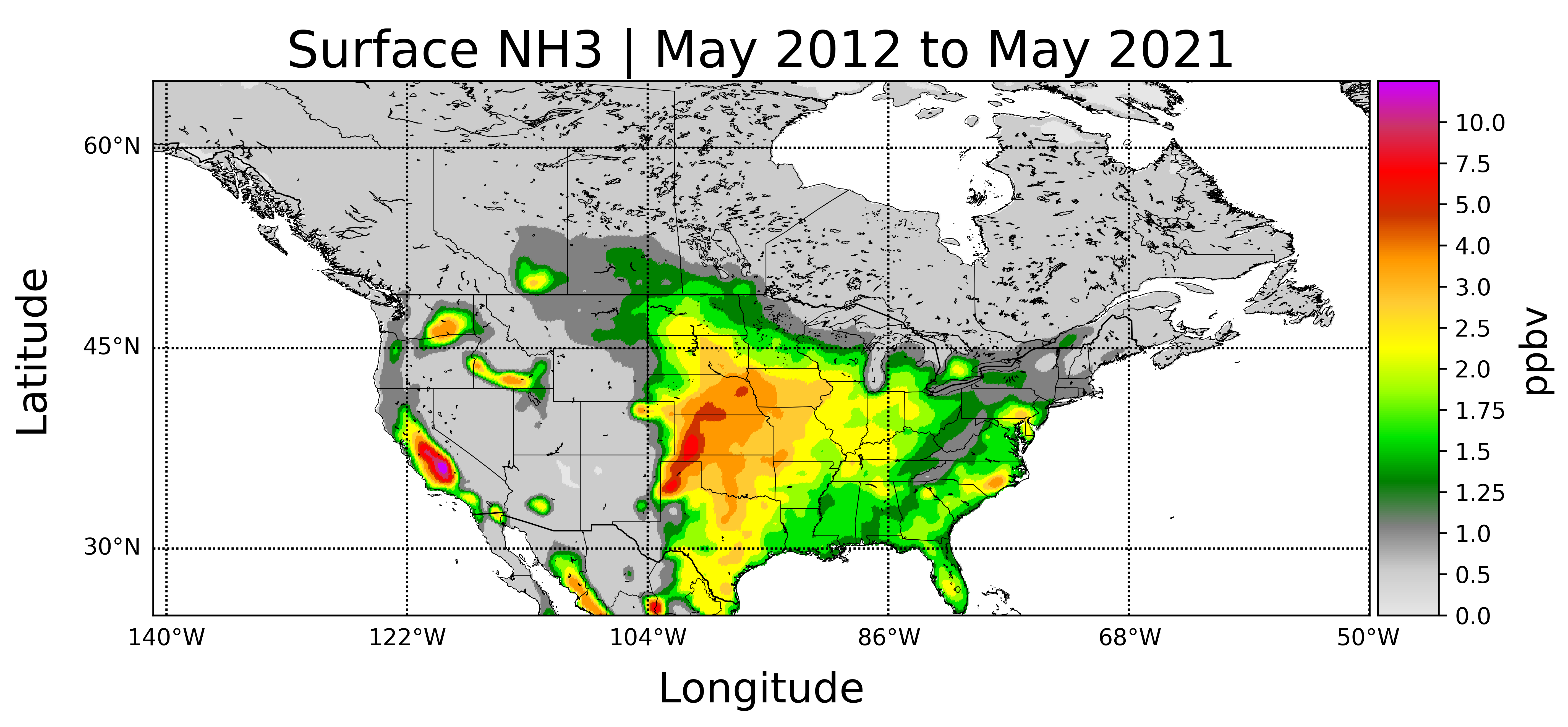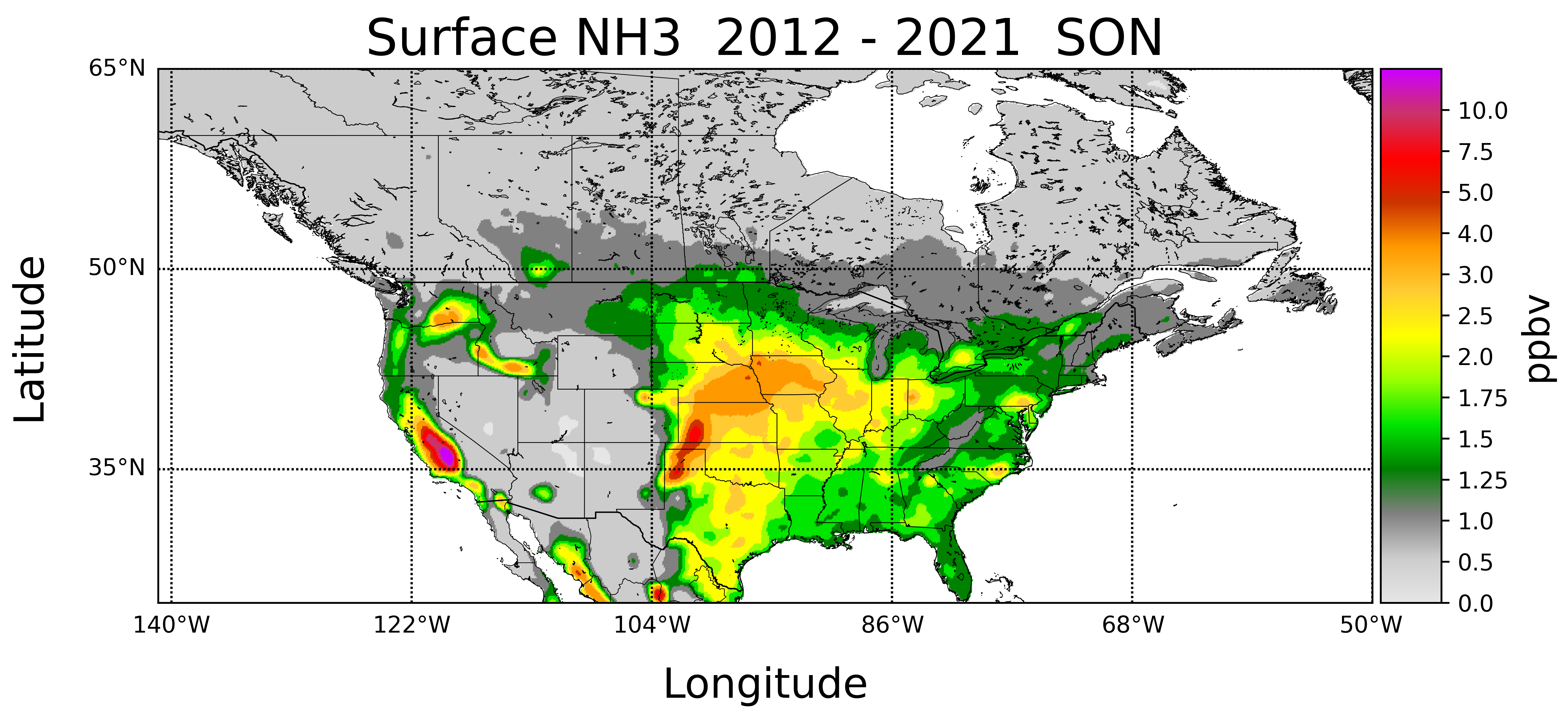Satellite Ammonia Monitoring (SAM)
Ammonia (NH3) is one of the most common forms of reactive nitrogen and the primary alkaline gas in the atmosphere. NH3 plays an important role in atmospheric chemistry and is one of the key components for aerosol (particulate matter (PM 2.5)) formation. Globally, NH3 in situ measurement networks are sparse in nature, have instruments with poor temporal resolution (for example, bi-weekly or monthly periods) and lack extensive spatial coverage. On the other hand, satellite observations of NH3 with daily global coverage are now being used to fill in the measurement gap and provide unprecedented information of global NH3 concentrations.
Global:

The multi-year (9-year; May 2012 to May 2021) average of Cross-track Infrared Sounder (CrIS) retrieved surface level NH3 concentrations. The NH3 hotspots regions generally coincide with agricultural regions across the globe. For example, the Indo-Gangetic Plain in India and Pakistan, the Nile Delta in Egypt, California's Central Valley and the central US and Canada, the Po Valley in Italy and Ebro Valley in Spain, south central Thailand, Indonesia, regions in eastern China and many other agricultural regions.
North America:
Annual:

The multi-year (9-year; May 2012 to May 2021) average of CrIS retrieved surface level NH3 concentrations over North America. The larger NH3 concentration hotspots are located in the Central Valley in California, central US states, and parts of Idaho and Washington states. Compared to the NH3 concentration hotspots in the US, Canadian NH3 hotspots tend to be smaller and located in Lethbridge, Alberta and south-western Ontario.
Seasonal:
Winter:

Spring:

Summer:

Fall:

The multi-year seasonal spatial distribution of CrIS retrieved surface level NH3 concentrations over North America during winter (December-January-February, DJF), spring (March-April-May, MAM), summer (June-July-August, JJA), and fall (September-October-November, SON). The high NH3 concentrations occurred in the springtime associated with fertilizer and manure applications and in the summertime associated with increased temperatures, which promote greater volatilization. The high NH3 concentrations in the non-agricultural northern-latitude regions during the drier summer season are associated with wildfires.
Datasets Availability:
The CrIS Fast Physical Retrievals (CFPR) ammonia datasets from both SNPP and NOAA20 are available from Environment and Climate Change Canada (ECCC).
The CrIS CFPR provides a retrieved NH3 product (surface and column amount) with averaging kernels and error covariances that are valuable for comparisons and model applications.
A user account to obtain the CrIS NH3 datasets is available by contacting ECCC.
More details on the CrIS CFPR data uses are described in “CrIS NH3 data usage statement”.
References:
White, E., Shephard, M. W., Cady-Pereira, K. E., Kharol, S. K., Ford, S., Dammers, E., Chow,
E., Thiessen, N., Tobin, D., Quinn, G., et al.: Accounting for Non-Detects: Application to
Satellite Ammonia Observations. Remote Sens., 15, 2610. https://doi.org/10.3390/rs15102610,
2023.
[Link]
Shephard, M. W., Dammers, E., Cady-Pereira, K. E., Kharol, S. K., Thompson, J., Gainariu-
Matz, Y., Zhang, J., McLinden, C. A., Kovachik, A., Moran, M., Bittman, S., Sioris, C. E.,
Griffin, D., Alvarado, M. J., Lonsdale, C., Savic-Jovcic, V., and Zheng, Q.: Ammonia
measurements from space with the Cross-track Infrared Sounder: characteristics and
applications, Atmos. Chem. Phys., 20, 2277-2302, https://doi.org/10.5194/acp-20-2277-2020,
2020.
[Link]
Kharol, S. K., Shephard, M. W., McLinden, C. A., Zhang, L., Sioris, C. E., O'Brien, J. M., Vet,
R., Cady-Pereira, K. E., Hare, E., Siemons, J., and Krotkov, N. A.: Dry deposition of reactive
nitrogen from satellite observations of ammonia and nitrogen dioxide over North America,
Geophys. Res. Lett., 45, 1157-1166, https://doi.org/10.1002/2017GL075832, 2018.
[Link]
Shephard, M. W. and Cady-Pereira, K. E.: Cross-track Infrared Sounder (CrIS) satellite
observations of tropospheric ammonia, Atmos. Meas. Tech., 8, 1323-1336,
https://doi.org/10.5194/amt-8-1323-2015, 2015.
[Link]